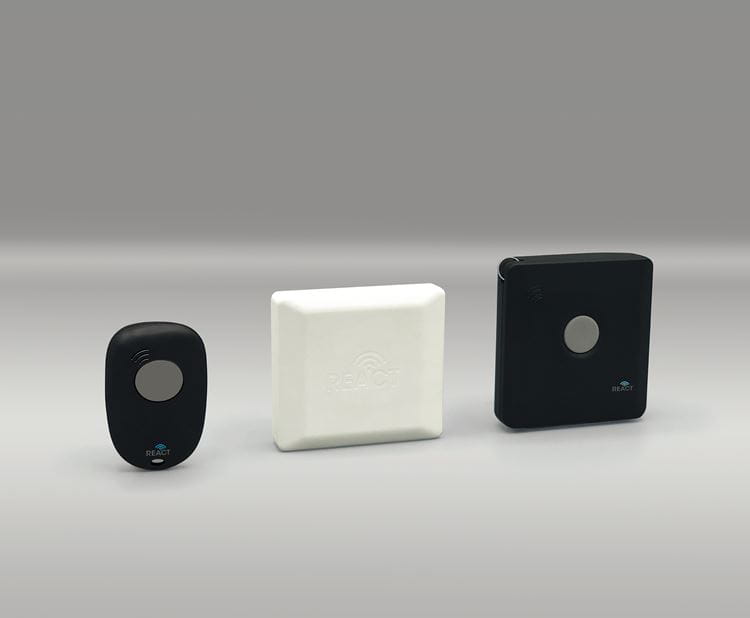Wearables
Let us help you build a wearable that will stand out in the health and fitness market

Nordic Semiconductor today announces that leading U.S. global supplier of panic buttons to hotels, React Mobile, is employing a Nordic nRF9160 multi-mode LTE-M/NB-IoT System-in-Package (SiP) and nRF52811 Bluetooth LE System-on-Chip (SoC) at the heart of its brand-new all-in-one React Mobile Cellular LTE Panic Button. The device also uses an eSIM from Nordic cellular IoT partner and global cellular communication specialist, iBASIS.
React Mobile says hotel employee panic buttons have traditionally been unable to connect direct to the Cloud and so have had to be tethered to some kind of network or gateway to operate. React says this adds a layer of complexity that can cause potential reliability issues such as outages and ‘dead spots’. By using a combination of cellular IoT, GPS and Bluetooth wireless technology, however, React Mobile says it has been able to eliminate any need for a network or gateway to operate. This boosts reliability to safety-critical standards using a simple, cost-effective LTE device that when activated connects instantly to the local cellular network.
In operation, each React Mobile Cellular LTE Panic Button has its own unique employee ID and if the user needs help, they simply press a single button that gives what’s termed ‘retentive force feedback’ to reassure them that their distress call has been successfully made. On-site Bluetooth LE beacons are used to provide the exact location (down to specific floor and room number) of the employee. This means distress signals sent via cellular LTE-M go direct to a company’s on-site security team who can react immediately, while the employee’s location continues to be tracked in real-time. And if the button is activated off a property, then GPS is used to locate and continuously track the employee.

The Panic Button comes in multiple, slim palm-sized form factors allowing it to be worn and activated discretely in a wide range of everyday hospitality use case scenarios. And the use of a military-grade ABS composite is claimed to make it capable of withstanding a 10 meter drop, and IP53-grade water and dust resistance to said to make it capable of operating reliably in real-world hospitality operating environments.
“We selected the Nordic Semiconductor nRF9160 SiP because it is the lowest power and most highly integrated cellular IoT solution on the market including support for GPS,” comments Riley Eller, CTO at React Mobile. “Allied to an equally legendary ultra low power Nordic Bluetooth LE chip, this enabled us to achieve an operating life in excess of three months between recharges [from a rapid-charge rechargeable lithium ion internal battery] which makes it almost zero cost for hospitality chains to maintain. This is further enhanced by support for Over-the-Air [OTA] firmware updates in the field.”
Because of the vital role played by the local cellular IoT network link in this application, React Mobile selected an eSIM from iBASIS that not only allows its panic alarm to be used all round the world, but also automatically searches for and maintains the strongest cellular IoT signal in any particular location using highly sophisticated and patented dynamic carrier selection technology from iBASIS.
React Mobile says its cloud-based system can interface with all major Cloud platforms and installation can be done within days even on large hospitality sites because the system requires no wires, servers, or even holes to be drilled (the beacons are attached using ultra strong adhesive).
“Although it’s uncomfortable and unpleasant to think about, in reality many employees in the hotel and hospitality industry worldwide experience dangerous situations in isolation,” continues Eller. “From medical emergencies to sexual misconduct and attacks, employees often find themselves in harmful scenarios without an easy way to call for help. Aside from the obvious pain of the individual’s experience, these incidents can destroy employee morale, as well as brand reputation. It’s sad, but it’s true.
“To us if you’re part of a team that oversees hotel and hospitality staff, you have mandates to provide your employees with panic buttons. On top of protecting your employees, having a solid safety solution in place for your staff reduces your liability, increases brand reputation, and improves employee recruiting and retention. And depending on your insurance structure and provider, it may even reduce your insurance costs.”
“While personal emergency alarms are not uncommon,” comments Svein-Egil Nielsen, CTO of Nordic Semiconductor, “alarms that use standalone cellular networks without needing to be paired to a smartphone or gateway are. This means it’s now possible to bring the legendary security and reliability of cellular wireless communication to personal safety devices.
“In addition, the cellular IoT version of traditional voice and data cellular wireless technology not only has a range and buildings penetration that far exceeds regular wideband cellular signals used by smartphones, but can also be made so low power that it can support small battery-powered devices which, if based on our nRF9160 SiP, offer class-leading power consumption and physical size and weight miniaturization as well.”
Let us help you build a wearable that will stand out in the health and fitness market